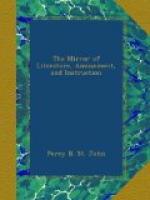The papers abovementioned, together with a few letters from the Doge to the Venetian ambassador at Milan, and one or two other not very important documents contained in the archives of Venice, all printed by Comte Dam, are the sole authentic vouchers for this conspiracy now known to exist; and it must be confessed that they are insufficient for its elucidation. The Abbe St. Real, who for a long time was esteemed the chief historian of this dark transaction, is an agreeable and attractive writer; but—since he was unacquainted with the report of the X; since he does not cite the correspondence of the French ambassador containing Pierre’s depositions; and since he frequently varies from a MS which he does cite, The Interrogatories of the Accused,[12] a MS indeed, which, even when quoted faithfully, is often contradicted by the few established facts, and by numerous well-known usages of the Venetian government,—little faith can be attached to his narrative. It was his opinion, and it has been that which has most generally prevailed, that the Duke d’Ossuna, the Marquis de Bedemar, and Don Pedro di Toledo, governor of Milan, mutually concerted a plan for the destruction of Venice; the chief execution of which was entrusted to Pierre and Renault: and that, on the very eve of its explosion, Jaffier, one of their band, touched by the magnificence of the Espousals of the Adriatic which he had just witnessed, was shaken from his stern purpose, and revealed the conspiracy. In order to overthrow the latter part of this hypothesis, it may be sufficient to state that the first executions took place on the 14th of May, 1618, and that it was not till the 24th of that month that the Feast of Ascension, and its gorgeous ceremonies, occurred in the same year.
[12] A translation of this
document is given by Daru: the
original Italian may be found
in the Memorie recondite of
Vittorio Siri, i. 407.
Comte Daru, on the other hand, first explains a design which it is notorious was entertained by the Duke d’Ossuna to convert his viceroyalty of Naples into a kingdom, the crown of which, wrested from Spain, should be placed on his own head. And hence he establishes the impossibility that d’Ossuna should at the same moment be plotting the overthrow of Venice; that power whose assistance, or at least whose connivance was one of the weapons most necessary for his success. On these grounds, Comte Daru contends that the Duke maintained a secret understanding both with the Signory and the court of France; that, refining on political duplicity, he deceived Pierre by really instructing him to gain over the Dutch troops quartered in the Lagune; not, however, as his emissary supposed, to be employed ultimately for the seizure of Venice, but in truth for that of Naples; that Pierre’s courage was not proof against the dangers with which his apparently most hazardous commission beset him; and that accordingly he betrayed




